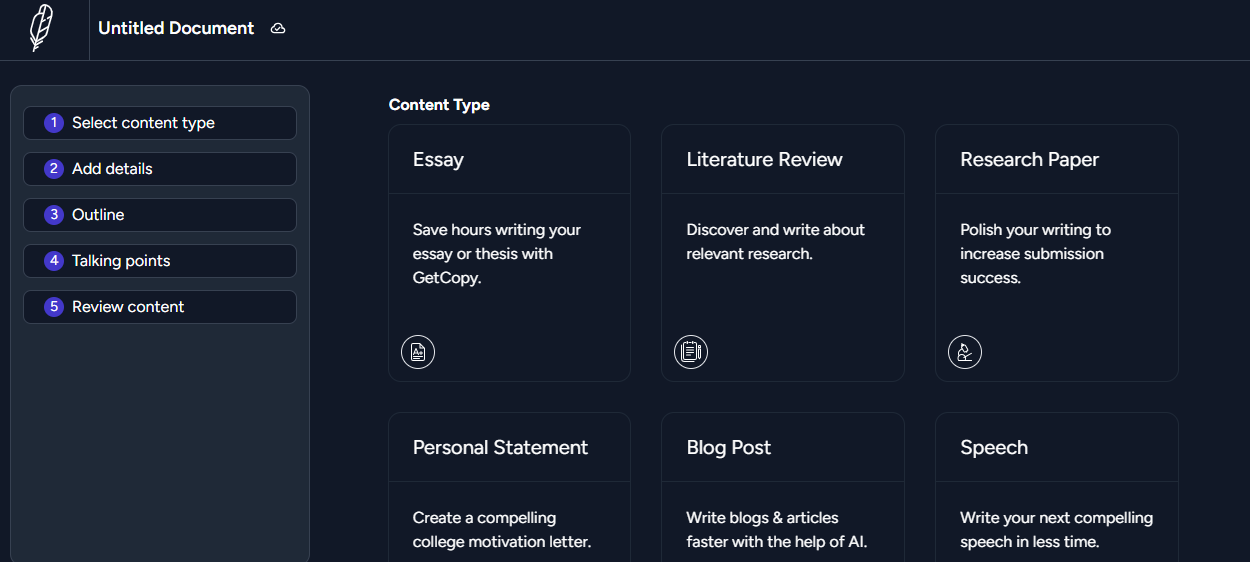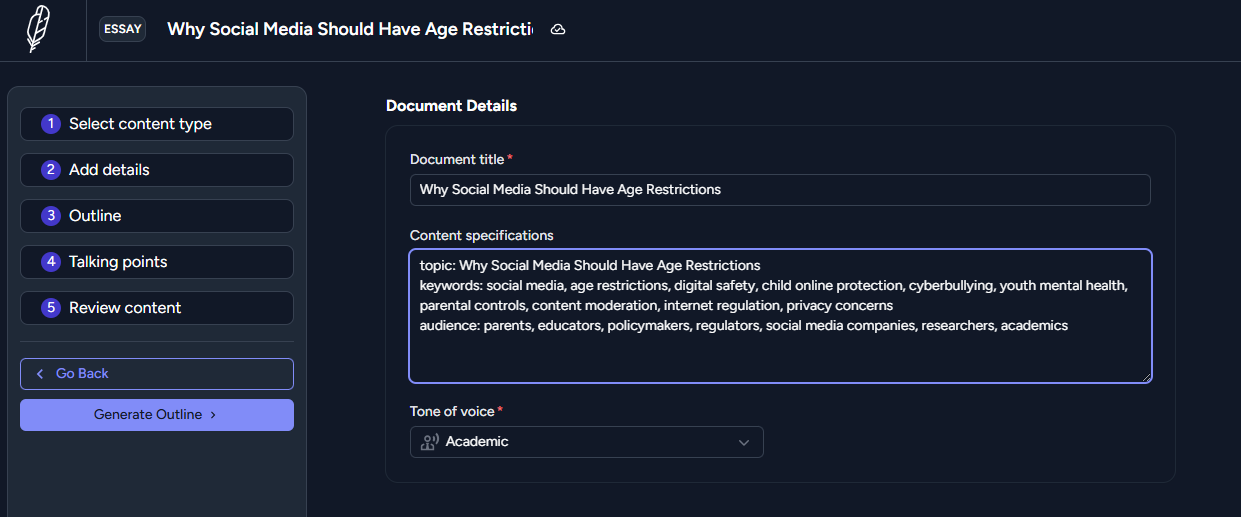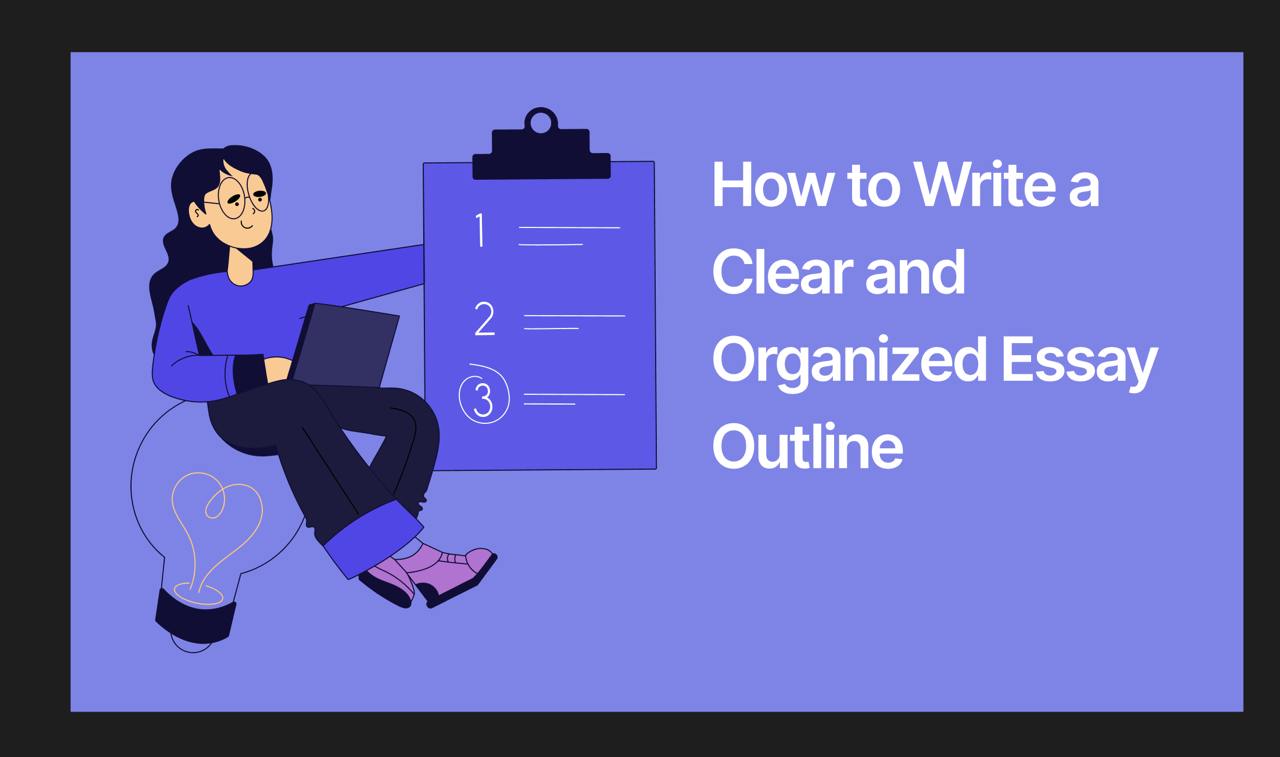The difficulties of essay writing can begin with the first step: writing a clear and organized outline. An essay outline is a structure that organizes your ideas into an argumentative piece. For both beginners and seasoned essay writers, learning to outline has great potential to improve one’s writing.
Outlining goes beyond gathering ideas ahead of writing; it maps the writer’s and reader’s journey to ensure a strong central idea guides the essay's direction.
This article will explain the components and how to write an essay outline. We will explain components, tips, and everything else needed to make your writing better and your essays more powerful. Come with us and learn how to create a coherent and readable essay outline that will improve your writing.
What is an Essay Outline
Before proceeding to write, it is important to first explore the topic deeply to correctly present ideas in the essay. Something that can help in this process is creating an outline for your essay.
An outline supports the organization of an idea and gives a clear structure of the important thoughts and concepts that an essay wishes to discuss or elaborate on.
Essay outlines help organize and manage the most important ideas so that an essay can be maximized into an introduction section, main paragraph body sections, and a final sentence in the conclusion. Making an outline ensures details can be clearly thought out and reduces the chances of straying away from the argument that was in place while increasing the chances of a smooth, logical flow of ideas.
Main Parts of an Essay
Essays consist of three fundamentals, which are the opening statement, the body paragraph detail sections, and summarizing the closing statement. Each part is integral to presenting your reasoning and the details that would back it up and each has a special task to perform in providing support to your argument.
Introduction—The first part of the essay provides the topic for discussion, details, and suggestions concerning the topic, and the claim or thesis statement. An introduction must arouse interest in the essay's subject to ensure that the body of the essay is discussed with interest.
Body Paragraphs – The Main part of the essay, in which major claims and disputes are put forth. The paragraphs should bring out fresh points each deriving from the core aim that was provided in the thesis statement. A combination of various paragraphs under one title should make a smooth flow within themselves and with other titled paragraphs.
Conclusion – The last part wraps up the discussion by bringing together the highlights. A well-written conclusion can profoundly alter the reader’s perception of the text by emphasizing central points, presenting their findings, or proposing new ideas to contemplate.
After comprehending these vital methods, it's guaranteed that your essay is coherent organized, and remains persuasive throughout the entire essay process.
How to Outline an Essay Effectively
An effective outline is crucial to an essay. It serves as a guide for the writer and provides hints about the writer’s overall thoughts and ideas. Following this guide will help formulate an outline that not only makes the writing process easy but also improves the quality of the resulting essay.
1. Establish the Aim of the Essay
Before actually preparing your outline, what is the reason for writing the essay? What is the claim or one central point to be communicated? You don’t need to have your thesis statement fully defined, but you do need some form of a working strategy. This will help you improve your brainstorming sessions while skimming off excess details.
A good example is attempting to capture your essay’s main argument in a single sentence. If this seems confusing or overly broad, do not proceed until you have solved that problem.
2. Filtering Through The Fluff
While brainstorming is necessary, there is no guarantee that all the ideas will make it into the final outline. Now, go back through your notes and ask yourself, does this really help me prove my thesis? If your response is ‘no,’ don't spend any more time on that point. Concentrate on ideas that further bolster your argument and have a positive impact on the essay.
You may try categorizing ideas while brainstorming to help see patterns. This can assist you in structuring related arguments and removing ineffective ones more easily.
3. Identify the Key Points for Each Paragraph
After selecting the most appropriate ideas, the next step is to decide how to put them together in the form of an essay. Each body paragraph must tackle a single key argument or one of the supporting points. Write the major sections of your essay and consider what details will help support them.
As an example, when attempting to justify an argumentative essay about the necessity for water fountains in the school, you might organize your essay in this manner.
Thesis Statement: More water fountains are advantageous to students and nature.
Body paragraph 1: Students do not have to buy bottled water, thus saving money.
Body paragraph 2: Lessening the use of plastic results in reduced pollution.
Body paragraph 3: Easy access to water encourages students to drink, lessening the likelihood of overheating.
Conclusion: Summary of the main arguments followed by the appeal to the audience to consider why water fountains should be made use of strongly.
It is also essential to ensure that there is logical progression between each of the paragraphs. To help with coherence and clarity use transition words and phrases.
4. Utilize a Standard Outline Template
The standardized template should be able to match the structure of the essay you intend to write. Keep in mind that most essays follow a certain skeleton structure, which includes:
Beginning: Attention grabber, data provided, and the main sentence.
Body Paragraphs: Main idea sentence, data provided in support, analysis, and the conclusion of the paragraph.
Closing: Rephrasing the key points, conclusion remarks, and final call to action (if necessary).
Each form has its own specifics, and it is best to follow the particular structure when writing an analytical, argumentative, or narrative essay.
Your outline may also include shorthand phrases, bullet points as well as sub-headings to streamline the text to make it easier to follow during the creation of the required structure instead of full sentences.
5. Use AI Options to Implement Other Functions
With new technology, improving your outline for each paragraph in an essay can be easier than ever. AI-powered tools can help with brainstorming, finding gaps in your reasoning, and structuring everything in an essay.
Use AI to suggest topics when the thesis is preoccupied with other parts of the outline.
Allow these tools to oversee your work to offer you clarity on logical flow and structure.
Also, test if the points you used are appropriately organized by AI-generated summaries.
AI can take away the hard work out of the structure and working out the core concept but don’t depend on it. It is always advisable to adapt every point to ensure that the AI tools have not taken over your perspective completely.
Example
If you want to know how to write an essay outline, you should see a few examples by your side. Imagine you’re writing an essay about “Why Social Media Should Have Age Restrictions”. Here is an example of the possible essay outline:
Introduction:
Hook: Shocking fact about social media addiction in children.
Brief background on current social media policies.
Thesis statement: Age restrictions should be enforced to protect mental health, prevent cyberbullying, and reduce screen addiction.
Body Paragraph 1: Mental Health Concerns
The impact of social media on self-esteem and anxiety.
Supporting studies on teenage depression linked to excessive social media use.
Body Paragraph 2: Cyberbullying Prevention
Statistics on cyberbullying cases among minors.
How stricter age restrictions could help prevent online harassment.
Body Paragraph 3: Reducing Screen Addiction
Negative effects of prolonged screen time on cognitive development.
Comparison of social media regulations in different countries.
Conclusion
Restate the thesis and key points.
Suggest practical solutions for better online safety.
How to Write an Essay Outline with GetCopy AI
AI tools have become an important tool for students. They can also be valuable during outlining and structuring an essay. Within dozens of tools, GetCopy AI can be a great choice. It simplifies the process of writing, editing, and outlining the essay. Finally, with the help of critical and creative thinking, the AI-generated outline can become much better.
With GetCopy AI, you can quickly generate an essay outline by following these steps:
Create a new document, then choose the “Wizard Document.” Choose the essay as the content type.

Fill in the document details. Name the document and add specifications like keywords and audience. Choose the tone of voice.

Click the “Generate Outline” button to receive a structured breakdown of your essay. GetCopy will suggest the best outline for your essay.
After generating the outline, it’s time to generate “Talking points”. GetCopy will suggest an introduction, main points for body paragraphs, and a conclusion based on your input.
Modify and expand key points. Review the generated outline and make necessary adjustments.
Add your personal thoughts and ideas to te generated content to make it more human and creative. Save the document when you think it’s ready.
FAQs
1. What’s the point of having an outline for an essay?
An outline streamlines your thoughts prior to writing by categorizing them into sections and sub-sections. This makes it easier to defend your arguments. Additionally, writing without an outline may pose challenges in following a logical sequence, which may lead to a lack of coherence within the essay. Outlines act as a guide, steering the writer in the right direction and helping them avoid getting sidetracked.
2. What do you consider the fundamentals of an outline for an essay to be?
The basics of an outline for an essay consist of an introductory paragraph, a body paragraph, and a concluding one. A hook along with background information is provided in the first paragraph and followed by a claim which will be supported in the body section. The body part contains the different arguments that support the claim. Lastly, the concluding paragraph synthesizes the key points discussed and restates the main claim. With the sub-topics provided, the args and the conclusion focus on the claim, making it easier for logical flow.
3. Is changing an outline while writing the essay acceptable?
Yes. Rigid outlines are limiting, so it is ideal to set boundaries. While creating the content, if a person already has ideas set, those may be put in an order where points can be pulled out and can be more refined. If there is nothing set, simply placing out arguments will create a jumble of different ideas that are not related to each other. Thus, there would be no coherence in the essay, which is not ideal.
4. What role do tools like GetCopy AI play in assisting a user to create the outline of a write-up?
AI tools can aid in outlining by creating skeletons related to your topic and ideas. GetCopy AI, for example, helps in organizing the argument, suggesting logical bridges, and improving these statements. While AI can be a helpful aid, it is critical to check the modified outline for plagiarism and make it custom-fit to your writing techniques.
5. What are some of the mistakes that students make when outlining that are more common than other ones?
The most common mistake is writing outlines that are either too broad or too specific. A vague outline has no directions for expanding it into an essay. Adding too many details also becomes impossible to work with. Another mistake is not assuring the logic of arguments, which circulation of ideas. The outline without a thesis also guarantees weak arguments and the ineffectiveness of the structure.
6. In what way can I enhance the strength of my essay outline?
A well-crafted outline starts from a focused and comprehensive thesis statement. Each body paragraph must revolve around the thesis and logically lead into one another. Subheadings keep everything organized, and prewriting reviews of the outline maintain clarity and order.

